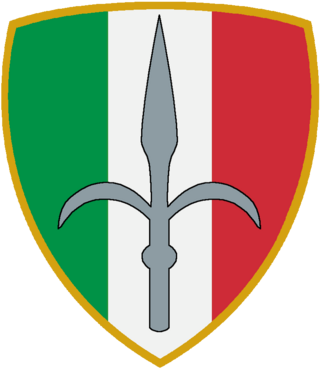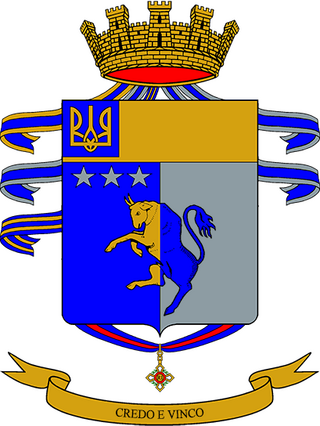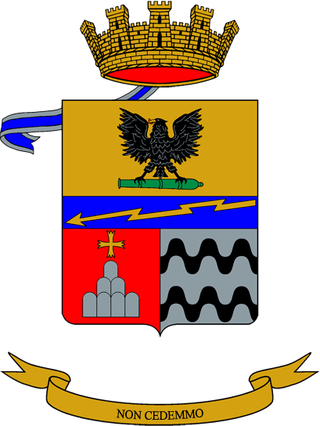History
The Italian Army undertook a major reorganization in 1975 during which the regimental level was abolished and battalions came under the direct command of multi-arms brigades. Tensions with Yugoslavia over the city of Trieste were allayed by the Treaty of Osimo, and mandatory military service was reduced from 15 to 12 months for the army and air force and from 24 to 18 months for the navy. The army reduced its forces by nearly 45,000 troops. It was decided that the units assigned to the Infantry Division "Folgore" would contract to brigade. After disbanding most units of the division, the remaining units were used to raise the Mechanized Brigade "Gorizia" in Gorizia on 1 November 1975. The brigade's command was created by reorganizing and renaming the command of the 82nd Infantry Regiment "Torino" in Gorizia. After the activation the "Gorizia" brigade entered the Mechanized Division "Folgore", which was part of the 5th Army Corps based in North-Eastern Italy. The 5th Army Corps was tasked with defending the Yugoslav–Italian border against possible attacks by the Warsaw Pact or Yugoslavia. The Gorizia was to defend the city of Gorizia and the brigade's two infantry fortification battalions were tasked to man and hold the fixed positions of the Alpine Wall. The brigade's strength was around 5,000 men and it was composed of the following units:
-
 Mechanized Brigade "Gorizia", in Gorizia [1] [2] [3]
Mechanized Brigade "Gorizia", in Gorizia [1] [2] [3] - Command and Signal Unit "Gorizia", in Gorizia
-
 33rd Infantry Fortification Battalion "Ardenza", in Fogliano Redipuglia (former III Battalion, 53rd Position Infantry Regiment "Umbria", fielded 10x companies) [4] [5]
33rd Infantry Fortification Battalion "Ardenza", in Fogliano Redipuglia (former III Battalion, 53rd Position Infantry Regiment "Umbria", fielded 10x companies) [4] [5] -
 41st Mechanized Infantry Battalion "Modena", in Villa Vicentina (former Amphibious Battalion "Isonzo" of the disbanded Lagunari Regiment "Serenissima") [6]
41st Mechanized Infantry Battalion "Modena", in Villa Vicentina (former Amphibious Battalion "Isonzo" of the disbanded Lagunari Regiment "Serenissima") [6] -
 63rd Infantry Fortification Battalion "Cagliari", in San Lorenzo Isontino (former II Battalion, 53rd Position Infantry Regiment "Umbria", fielded 12x companies) [4]
63rd Infantry Fortification Battalion "Cagliari", in San Lorenzo Isontino (former II Battalion, 53rd Position Infantry Regiment "Umbria", fielded 12x companies) [4] -
 82nd Mechanized Infantry Battalion "Torino", in Cormons [1] (former II Battalion of the disbanded 82nd Infantry Regiment "Torino")
82nd Mechanized Infantry Battalion "Torino", in Cormons [1] (former II Battalion of the disbanded 82nd Infantry Regiment "Torino") -
 183rd Mechanized Infantry Battalion "Nembo", in Gradisca d'Isonzo [7] (former IV Battalion of the disbanded 183rd Infantry Regiment "Nembo")
183rd Mechanized Infantry Battalion "Nembo", in Gradisca d'Isonzo [7] (former IV Battalion of the disbanded 183rd Infantry Regiment "Nembo") -
 22nd Tank Battalion "M.O. Piccinini", in San Vito al Tagliamento (Leopard 1A2 main battle tanks, former XXII Tank Battalion of the disbanded Lagunari Regiment "Serenissima") [6]
22nd Tank Battalion "M.O. Piccinini", in San Vito al Tagliamento (Leopard 1A2 main battle tanks, former XXII Tank Battalion of the disbanded Lagunari Regiment "Serenissima") [6] -
 46th Field Artillery Group "Trento", in Gradisca d'Isonzo (M114 155mm towed howitzers, former I Self-propelled Field Artillery Group of the disbanded 33rd Field Artillery Regiment)
46th Field Artillery Group "Trento", in Gradisca d'Isonzo (M114 155mm towed howitzers, former I Self-propelled Field Artillery Group of the disbanded 33rd Field Artillery Regiment) -
 Logistic Battalion "Gorizia", in Gradisca d'Isonzo
Logistic Battalion "Gorizia", in Gradisca d'Isonzo - Anti-tank Company "Gorizia", in Gorizia (BGM-71 TOW anti-tank guided missiles)
- Engineer Company "Gorizia", in Cormons
On 31 October 1986 the Italian Army abolished the divisional level. Brigades, which had until then been under one of the Army's four divisions, came under the direct command of the Army's 3rd or 5th Army Corps. Thus the Gorizia came under the direct command of the 5th Army Corps. From the disbanded "Folgore" Division the Gorizia received the 53rd Infantry Fortification Battalion "Umbria", in Pavia di Udine, and at the same time ceded the 33rd Infantry Fortification Battalion "Ardenza" to the Mechanized Brigade "Vittorio Veneto".
After the end of the Cold War the Italian Army began to draw down its forces: first the 63rd Infantry Fortification Battalion "Cagliari" was disbanded on 30 November 1991, followed by the 53rd Infantry Fortification Battalion "Umbria" on 31 March 1993, while the 183rd Mechanized Infantry Battalion "Nembo" was transferred to the Paratroopers Brigade "Folgore" in 1991. During the same year the 184th Self-propelled Field Artillery Group "Filottrano" replaced the 46th Field Artillery Group "Trento". [8] At the same time for traditional reasons the battalions were renamed as regiments without changing composition or strength. For the last year of its life the brigades was composed of the following units:
-
 Mechanized Brigade "Gorizia", in Gorizia
Mechanized Brigade "Gorizia", in Gorizia
On 30 September 1995 the 41st Infantry Regiment was disbanded. On 30 October 1996 the brigade was disbanded with the rest of its units. [8] Only the 82nd Infantry Regiment "Torino" remained active and was transferred to the Mechanized Brigade "Mantova".

The Lagunari Regiment "Serenissima" is the active unit of Italian Army's infantry arm's amphibious Lagunari speciality. The name of the specialty comes from the Italian word for lagoon, while the regiment's name "Serenissima" commemorates the Most Serene Republic of Venice. The regiment is based in Venice and assigned to the Cavalry Brigade "Pozzuolo del Friuli". The "Pozzuolo del Friuli" brigade forms, together with the Italian Navy's Third Naval Division and San Marco Marine Brigade, the Italian Armed Forces' Sea Projection Force.

The Paratroopers Brigade "Folgore" is an airborne brigade of the Italian Army. Its core units are three battalions of paratroopers (paracadutisti). The name "Folgore" is Italian for lightning. The Folgore is one of three light infantry brigades of the Italian Army. While the Folgore specializes in parachute operations its sister brigade in the Division "Vittorio Veneto" the Airmobile Brigade Friuli specializes in helicopter assault operations. The Folgore and its units are based in Tuscany, Veneto and Lazio.
On March 1, 1984 the Italian Institute for Disarmament, Development and Peace (Istituto di ricerche per il disarmo, lo sviluppo e la pace in Rome published the entire Italian Army order of battle down to company level – this was justified by the radical party as one of its core demands was total disarmament of Europe, even though the data which was published was top secret. The Radical Party dissolved in 1989 and the IRDISP followed suit in 1990. But Radio Radicale has survived, and the OrBat can still be found today on the homepage of the radio.

The Cavalry Brigade "Pozzuolo del Friuli" is a brigade of the Italian Army, based in the Friuli-Venezia Giulia and Veneto regions. The Brigade consists of a command unit, a cavalry regiment, an amphibious infantry regiment, an artillery regiment, an engineer regiment and a logistic regiment.

The Mechanized Brigade "Granatieri di Sardegna" is a mechanized infantry brigade of the Italian Army, based in Rome and central Italy. The brigade fields one of the oldest regiments of the Army and is one of the guard regiments of the President of Italy. The name of the unit dates back to the Kingdom of Sardinia and not the eponymous Mediterranean island of Sardinia. The brigade is part of the Division "Acqui".
The 184th Paratroopers Division "Nembo" was an airborne division of the Royal Italian Army during World War II. After the Armistice of Cassibile the division joined the Italian Co-belligerent Army's Italian Liberation Corps and together with the Polish II Corps liberated Ancona in the Battle of Ancona.

The Armored Brigade "Vittorio Veneto" was an armored brigade of the Italian Army. Its core units were armored and mechanized cavalry squadrons groups. The brigade's headquarters was in the city of Villa Opicina, with most of its units based in the Province of Trieste. The brigade's name was chosen to remember the decisive Italian World War I victory at the Battle of Vittorio Veneto.

The 132nd Armored Brigade "Ariete" is currently the only active armored brigade of the Italian Army. Its core units are tank and Bersaglieri regiments. The brigade's headquarters is in Pordenone, and most of its units are based in the North-East of Italy. The brigade's name comes from the battering ram. The brigade draws much of its historical traditions from the 132nd Armored Division "Ariete," which fought in the Western Desert Campaign of World War II. In 1948, the Ariete was reconstituted as a division and remained active until 1986. Today the brigade is part of the Division "Vittorio Veneto".

The Mechanized Brigade "Brescia" was a mechanized brigade of the Italian Army. Its core units were mechanized infantry battalions. The brigade was founded in, named after, and headquartered in the city of Brescia and accordingly the brigade's coat of arms was modeled after the city's coat of arms.

The Mechanized Brigade "Mantova" was a mechanized brigade of the Italian Army. Its core units were mechanized infantry battalions. The brigade's headquarters was in the city of Cividale del Friuli and all the brigade's units were based in the region of Friuli-Venezia Giulia. In 2003, the "Mantova" was raised again as a division command.

The Mechanized Brigade "Trieste" was a mechanized brigade of the Italian Army. Its core units were mechanized infantry battalions. The brigade's headquarter was in the city of Bologna. Named after the North-Eastern city of Trieste the brigade's coat of arms was modeled after the city's coat of arms.

The Mechanized Division "Folgore" was a mechanized division of the Italian Army. Its core units were three mechanized brigades. The brigades headquarters was in the city of Treviso.
The following is a hierarchical outline for the Italian Army at the end of the Cold War. It is intended to convey the connections and relationships between units and formations.

The Trieste Troops Command was an Italian Army brigade-sized command located in the city of the Trieste and tasked with the defense of the city in case of a Yugoslav-Italian war.
With the 1975 reforms the Italian Army abolished the regimental level and replaced it with brigades made up of multiple arms. During the reform the army disbanded 48 regimental commands and reduced its force by 87 battalions. A further ten regimental commands were used to raise ten new brigade commands. Ten training centers, which for traditional reasons had carried the names of regiments, were also disbanded. The reduction in units also allowed to mechanize most of the remaining units in Northern Italy and Italy's defense strategy changed from a hold-at-all-costs territorial defense to one of mobile warfare.

The 183rd Paratroopers Regiment "Nembo" is an active unit of the Italian Army based in Pistoia in Tuscany. The regiment is part of the Italian Army's infantry arm's Paracadutisti speciality and assigned to the Paratroopers Brigade "Folgore".

The Regiment "Cavalleggeri di Saluzzo" (12th) is an inactive cavalry unit of the Italian Army. The regiment was formed during the First Italian War of Independence and participated in the Second Italian War of Independence, Crimean War, and Third Italian War of Independence. In World War I the regiment fought dismounted on the Italian Front. During World War II the regiment was assigned to the 1st Cavalry Division "Eugenio di Savoia", which was deployed to occupied Yugoslavia on anti-partisan duty. The division and its units were disbanded after the announcement of the Armistice of Cassibile by invading German forces. During the Cold War the unit served as the reconnaissance group of the Mechanized Division "Folgore" and after 1986 as a mechanized group of the Mechanized Brigade "Vittorio Veneto". At the end of the Cold War the regiment was disbanded.

The 182nd Armored Infantry Regiment "Garibaldi" is an inactive unit of the Italian Army last based in Sacile in Friuli Venezia Giulia. The regiment was part of the Italian Army's infantry arm and was last assigned to the Infantry Division "Folgore".

The 82nd Infantry Regiment "Torino" is an active unit of the Italian Army based in Barletta in Apulia. The regiment is named for the city of Turin and part of the Italian Army's infantry arm. As of 2023 the regiment is assigned to the Mechanized Brigade "Pinerolo".

The 184th Artillery Regiment "Nembo" is an inactive field artillery regiment of the Italian Army, which was based in Gradisca d'Isonzo in Friuli-Venezia Giulia. Originally an artillery regiment of the Royal Italian Army, the regiment was assigned in World War II to the 184th Infantry Division "Nembo", which was Italy's second paratroopers divisions. After the announcement of the Armistice of Cassibile the division and regiment joined the Italian Liberation Corps and fought on the allied side in the Italian campaign. In 1944 the regiment joined the Combat Group "Folgore" of the Italian Co-belligerent Army and was assigned to the British XIII Corps. During the Cold War the regiment was assigned to the Infantry Division "Folgore" and from 1976 the Mechanized Division "Folgore". The regiment was disbanded in 1996. The regimental anniversary falls, as for all Italian Army artillery regiments, on June 15, the beginning of the Second Battle of the Piave River in 1918.

















